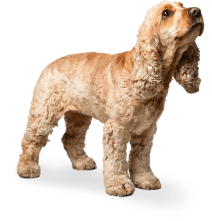

10 facts about sleeping dogs
Whether they’re curled up in bed, stretched out on a rug, or snuggled up as close as possible to the nearest human, dogs certainly love a good sleep. But did you know their eyes have a special eyelid just for sleeping, and that the position they sleep in can tell you lots about their mood? And what about duration – how much sleep do dogs need? And why do they sleep with their eyes open?
We’ve rounded up our top 10 facts about sleeping dogs and answered all these questions and more – including, of course, whether you should let sleeping dogs lie…
1. Dogs spend half their life asleep
That’s right. The average dog sleeps for about half of every day, or around 12–14 hours. And that figure rises for older dogs and larger breeds. But why do dogs sleep so much? The answer’s pretty simple. Their bodies do all the same things ours do when we sleep – recharge, repair and recuperate, ready for another day. The older they get, the more time they’ll need to do that, meaning you’re more likely to spot more and more sneaky afternoon naps.
2. Puppies snooze for even longer
While the average adult dog sleeps between 12 and 14 hours a day, puppies can spend anything from 18 to 20 hours in the land of nod. Like babies, their little bodies are growing and learning lots of new things, and their brains are processing all sorts of new information. They’re likely to spread their sleeps across the day in shorter bursts, rather than one long stint. As any puppy parent knows, it’s a lot like having a newborn.
3. Dogs have a third eyelid
It’s called the nictitating membrane – that pinkish tissue in the lower corner of their eye – and it covers their eye and keeps their eyeball moist while they sleep. Often, when your dog looks like it’s sleeping with its eyes open, you’re actually seeing the nictitating membrane. It also serves to remove debris from your dog’s eyes and protects that area from injuries.

4. They can also see in the dark
We’re not talking full-on night vision here, but it’s safe to say your dog can see much more than you can in the dark. It’s thanks to another special membrane, this time the tapetum lucidum, which reflects even the slightest bit of light into the retina and boosts their vision in the dark. A dog’s eye also has more rods than a human’s, which is another factor behind that impressive night vision.
5. It’s true what they say – you really should let sleeping dogs lie
We’ve all heard the old saying, that it’s better to ‘let sleeping dogs lie’. And the phrase comes from the universal truth that dogs can be unpredictable if they’re woken suddenly. They may bite or nip purely as a reactive response to being startled, so it’s always better to let your sleeping dog lie. If you really have to rouse them, do it with a gentle voice – not a hand. But don’t be tempted to wake them from a bad dream, as they may react badly.

6. That’s right, dogs do dream
Scientists are pretty sure our dogs’ sleep patterns are similar to our own, and that dogs dream in much the same way as we do. Research has shown dogs enter periods of REM sleep – which stands for Rapid Eye Movement – when the brain is more active. This is when they’ll process the day’s events, like that long walk, or that epic game of fetch, so don’t be surprised to see their little legs twitching like crazy.
7. Twitching is usually harmless, but can be a warning sign
Most dogs twitch at some point – a twitch is just an involuntary muscle spasm that often happens in the back legs, usually while your dog is in the active phase of sleep. But twitching that’s noticeably different from their normal pattern could indicate an underlying issue – anything from an anxiety disorder to epilepsy. If it’s more like a full-body tremor, they’re rigid, or foaming at the mouth, call an emergency vet as they may be having a seizure.
8. They'll get better rest in a comfortable bed
You'll know from experience that a mattress that's too soft, too hard, or too lumpy leaves you feeling tired and not your best the next morning. It needs to be just right. The same applies to your dog, especially if they're getting older. Some of the best dog beds have a memory foam mattress that moulds to the shape of your dog’s body, giving them a comfortable night’s rest. A slightly higher bed will make it easy for your pooch to get in and out, and padded walls will give them a place to rest their head. Take a look at our guide to 5 of the best beds for senior dogs.
9. Dog sleeping on their back? They might be too hot
There could be a very simple reason for your dog snoozing on their back, paws in the air – they just feel incredibly safe and secure. By making themselves vulnerable like this they’re placing total trust in you, so don’t worry if your pup prefers this sleeping position. That said, there’s a chance your dog could be trying to tell you it’s too hot, particularly in the summer. There’s less hair on their belly, so the heat can leave their body. Plus, as dogs sweat through their paws, in this position they’re getting plenty of air.
10. Your dog’s behind in your face is a sign of trust
Apparently. The thinking is, if your dog snuggles up to you this way around, they trust you with their life – literally. They know you won’t hurt them, and you’ll protect them, so they don’t need to keep an eye on you while they snooze. On the flip side, they can see what’s coming if they do need to spring into action – so they’re protecting you by keeping you behind them. We’ll take that as proof – as if we ever needed it – that dogs really are the best.
Looking for similar content? Check out some more interesting facts about dogs now. Or, find out if you should let your dog sleep in the bedroom.




